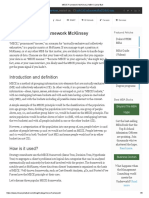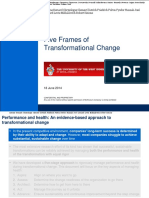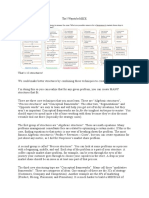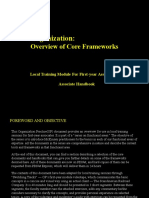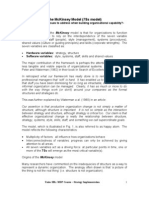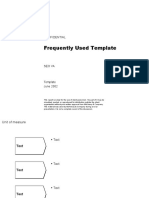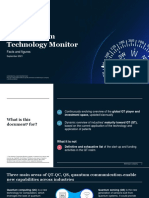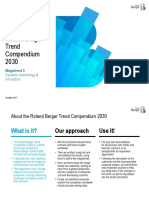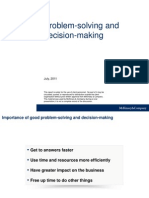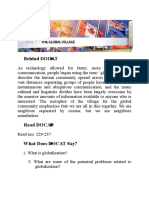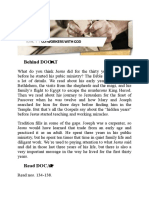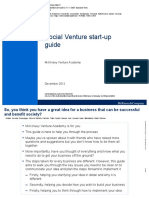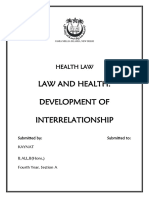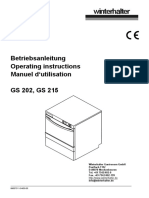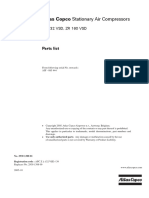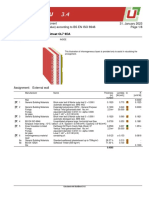7-Step Problem-Solving Process
Uploaded by
Lee7-Step Problem-Solving Process
Uploaded by
LeeNE-AAA123-20100119
Arendt Brinkmeyer Chesterton Chrysostom Dostoyevsky Foucauld Halimkesuma
Kasimo Kennedy Newman Origen Soemohardjo Spaemann Tertullian Tolkien Weil
Antoine Bernard Chrysologus Clement Dietrich Friedrich
Fulton Fyodor Hannah
José Leonard Lewis Mikhailovich Robert Simone
Introduction and recap of 7 steps
Exercise
Consulting as a career choice
McKinsey & Company | 1
NE-AAA123-20100119
Personal note: some of the problems from the last 15 years
Antoine Bernard Chrysologus Clement Dietrich Friedrich Fulton Fyodor Hannah José Leonard Lewis Mikhailovich Robert Simone
Amantius Athanasius Cantius Gaucherius Evagrius Fulgentius Ignatius Irenaeus Laurentius Nicasius Paschasius Pius
Procopius Stephanus Turibius Vergilius
§ As all of our base businesses are declining, where do we find new growth?
§ Our current functional organization is working well – would we benefit from a new
structure?
§ We are the market leader in a technology service business in countries A and B –
should we buy the market leader in country C?
§ Should we buy an energy company?
§ Should we ramp-up a distressed asset or just close it down?
§ What should be our position towards new expected pharma regulation?
§ How will a new production technology invented by competition impact us as the
market leader?
McKinsey & Company | 2
NE-AAA123-20100119
7-step problem-solving process
Amantius Athanasius Cantius Gaucherius Evagrius Fulgentius Ignatius Irenaeus Laurentius Nicasius Paschasius Pius Procopius Stephanus Turibius Vergilius
Think disaggregation
Think impact – & early hypotheses – Think speed –
Problem-solving What are we trying What could be key Which issues are
to answer? elements of the problem? most important?
Define Structure Prioritize
Problem problem problem issues
Communications Think efficiency – Plan analyses
Where and how should and work
the team spend its
time?
Develop Synthesize Conduct
recommendation findings analyses
Think potential Think “so what” – What Think evidence –
solution – What implications do our findings What are we trying
should the have for the company ? to prove/ disprove?
company do?
SOURCE: McKinsey McKinsey & Company | 3
NE-AAA123-20100119
Four capabilities that are critical to distinctive problem-solving
Arendt Brinkmeyer Chesterton Chrysostom Dostoyevsky Foucauld Halimkesuma Kasimo Kennedy Newman Origen Soemohardjo
Spaemann Tertullian Tolkien Weil
2 3
1 4
1 Constructing multi- 2 Identifying 3 Finding the 4 Stay ahead/step
ple perspectives relationships essence back
▪ The ability to see a ▪ The ability to discern ▪ The ability to cut ▪ The ability to think
problem and its connections/ through complexity to ahead of the team
aspects from many linkages between reveal the heart of and simultaneously
angles elements inside and the matter step back from the
outside the problem problem
SOURCE: McKinsey McKinsey & Company | 4
NE-AAA123-20100119
From problem solving to problem solving leadership
Nature of problem solving
CEO/
President ▪ More complex problems
▪ Often difficult to determine factor
EVPs driving the problem (e.g., customer
satisfaction score, profitability)
▪ Need to understand solution space,
VPs hypothesize and prioritize, and then
employ RCPS
Directors ▪ Responsible for creating a positive
problem solving culture for their
teams (e.g., viewing problems as
Team managers opportunities)
▪ More straightforward problems
Team leaders ▪ Simpler to identify the problem (e.g.,
claims processed)
Frontline
▪ Employ RCPS directly
▪ Resolution time is measured in days
McKinsey & Company | 5
NE-AAA123-20100119
Key skills in problem solving leadership
Creating a ▪ Defining the problem clearly
productive ▪ Coaching others through the problem solving process
problem solving ▪ Role modeling “go and see” to identify problems and root causes
environment
▪ Viewing problems as opportunities
▪ Encouraging a “test and learn”, safe to experiment culture
▪ Managing the problem solving process “flow” (velocity)
▪ Collaborating and involving others in the solution
Facilitating ▪ Maintaining appropriate link to meeting agenda/purpose
effective ▪ Focusing, using time wisely
meetings ▪ Engaging entire group to gain critical information
▪ Pushing on key questions related to core problem
▪ Synthesizing discussions; playing back information
Communicating ▪ Capturing most critical information to support analyses or hypotheses
Being ▪ Building trust
personally ▪ Time mastery
effective
McKinsey & Company | 6
NE-AAA123-20100119
Introduction and recap of 7 steps
Exercise
Consulting as a career
McKinsey & Company | 7
NE-AAA123-20100119
Step 1: Define the problem
Think IMPACT:
What is the question you
are trying to answer?
? !
Recom-
Problem Struc- Priori- Issue Syn-
Analysis menda-
definition turing tizing analysis thesis
tions
Problem Communication Impact
SOURCE: McKinsey McKinsey & Company | 8
NE-AAA123-20100119
Problem statement example: Oilco Refinery
Oilco Refinery is suffering from poor Statement of
profitability despite a strong market fact
niche position
Should Oilco Refinery improve its Not
deteriorating position? disputable
Can Oilco Refinery be managed Too general
differently to increase profitability?
What opportunities exist for Oilco to
improve profitabilty by $40 million S.M.A.R.T.
per year through overhead
rationalization, operational
improvements, or restructuring non-
core assets?
SOURCE: McKinsey McKinsey & Company | 9
NE-AAA123-20100119
Introducing Hiperama, our case company today
Context
▪ Consolidation… Spanish retail industry is rapidly consolidating and encountering
increasing price pressure from discounters and international retail chains
▪ Shopping behaviors changing… Spanish consumers are changing the way they
shop, focusing on convenience (e.g., prepared foods) and product assortment (e.g.,
one-stop-shopping), in response to lifestyle trends sweeping Europe (e.g., more
working women)
Company profile
▪ Spanish retailer…Hiperama is the hypermarket division of Grupo Abaceria, a Spanish
regional retail chain with supermarkets and discount stores in addition to hypermarkets
▪ Part of parent company…Grupo Abaceria controls approximately 3% of a 74 Euro
billion Spanish retail industry, and Hiperama’s revenues comprise approximately 700
Euro millions of that
▪ Business challenges…Hiperama has experienced declining revenues and operating
margins in the last few years, and a new major project has been launched to improve
Hiperama’s financial position and create a sustainable, compelling value proposition for
Hiperama in the face of competitive pressure from discounters, international retailers,
and other potential market entrants
The aspiration
▪ Hiperama’s CEO has expressed a desire to attain a 3.5% operating margin in the near
term and build a base for growth
SOURCE: McKinsey McKinsey & Company | 10
NE-AAA123-20100119
Part 1 of the exercise: Let’s define the problem
Basic question to be resolved
▪ The basic question brings focus to the analytic work. It should be SMART: specific, measurable, action-oriented,
relevant and time-bound. It should not be so narrow that important levers to solve the problem are missed
1 4
Perspective/context Constraints within solution space
▪ Sets out the “situation” and “complication” facing the ▪ Defines the limits of the set of solutions that can be
company, e.g., industry trends, relative position in the considered, e.g., must involve organic rather than
industry inorganic growth
2 5
Criteria for success Stakeholders
▪ Defines success for the project. Must be shared by ▪ Identifies who makes the decisions and who else could
management, stakeholders and team. Must include support (or derail) the project, e.g., CEO, Division
qualitative & quantitative measures, e.g., financial Manager, SBU Manager
returns, effect on staff
3 6
Scope of Solution Space Key sources of Insight
▪ Indicates what will and will not be included in the ▪ Identifies where best practice expertise, knowledge, and
project, e.g., international markets. projects approaches exist (within the company or within
the industry) - e.g., document from experts, databases,
previous projects…
SOURCE: McKinsey McKinsey & Company | 11
NE-AAA123-20100119
Hiperama Problem definition exercise (15 mins)
▪ Break out into your teams and create a
problem statement for Hiperama using
the structure on the handouts
SOURCE: McKinsey McKinsey & Company | 12
NE-AAA123-20100119
Sample work product for Hiperama
Basic question to be resolved
▪ What set of actions (operational and beyond) should Hiperama pursue over the next 5 years to ignite growth and
increase operating margins to 3.5%?
1 4
Perspective/context Constraints within solution space
▪ Consolidating industry with international/ domestic ▪ Regulated market prevents expansion in size of stores
players looking to grow presence in Spain ▪ Pricing below cost not permitted by law
▪ Price-based competitors rapidly gaining share
▪ Consumer demands changing towards service and
convenience while price remains a key factor
▪ Regulation restricting new hypermarket development
2 5
Criteria for success Stakeholders
▪ Operating margins of 3.5% ▪ Luis Gonzales (CEO) ▪ Store manager pilot
▪ Clearly articulated value proposition ▪ CFO project
▪ Roll-out plan capable of building organizational buy-in ▪ VP of HR ▪ VP of Operations
▪ Grocery Director
3 6
Scope of Solution Space Key sources of Insight
▪ Divestiture is not an option at this time ▪ Key Hiperama executives
▪ Focus on Spanish grocery retail market ▪ Nielsen or other retail & marketing information company
▪ Analyst reports
SOURCE: McKinsey McKinsey & Company | 13
NE-AAA123-20100119
Step 2: Structure the problem
Think DISAGGREGATION and
HYPOTHESIS:
What could the key elements of
the problem be?
? !
Recom-
Problem Struc- Priori- Issue Syn-
Analysis menda-
definition turing tizing analysis thesis
tions
Problem Communication Impact
SOURCE: McKinsey McKinsey & Company | 14
NE-AAA123-20100119
Quality logic trees are consistent, relevant, and MECE
First line Second line
of support of support
Consistent
Problem statement
worksheet
Basic question to
be resolved
1
Perspective/
3
Decision makers/
Relevant Mutually
2
context
4
stakeholders
Exclusive
Criteria for
success
Scope of
solution space Collectively
4
Barriers to impact
Exhaustive
Consistent
SOURCE: McKinsey McKinsey & Company | 15
NE-AAA123-20100119
2 main types of logic trees
Issue tree Hypothesis tree
Argument 1
Hypothesis
Issue (potential Argument 2
(question) answer)
Argument 3
“What?” or “How?” “Why?”
▪ Breaks issue or question into ▪ Asserts a possible solution, with
smaller issues/questions necessary proofs
▪ Addresses the entire solution space ▪ Narrows the solution space to focus
▪ Used for project starts or new problem-solving
problems ▪ Used when you have enough data
to support a hypothesis
SOURCE: McKinsey McKinsey & Company | 16
NE-AAA123-20100119
Main differences between issue tree and hypothesis tree
Issue tree Hypothesis tree
▪ To create a comprehensive ▪ To focus the analysis on those
overview of all the factors elements that we know
Purpose impacting the problem (assume) to have the most
impact on the end-product
▪ When there is a little evidence/ ▪ When we have data to prioritize
When to experience available to draft elements of the problem (based
use hypotheses on experience, experts input or
▪ Typically early in/before the initial analyses)
project (can be a very good
opening discussion with
managers and stakeholders)
▪ Questions ▪ Early (when possible) or after
What does ▪ Neutral initial analyses
it look like
▪ Comprehensive ▪ (Preliminary) Answers
▪ Guided
▪ Focused
SOURCE: McKinsey McKinsey & Company | 17
NE-AAA123-20100119
Exercise: Hiperama issue tree (30 min) HANDOUT (EXERCISE)
▪ Work as a team to develop an issue tree for Hiperama for 30 mins
▪ Remember the principles of good issue trees :
– Consistent
– Relevant
– MECE (Mutually Exclusive, Collectively Exhaustive)
?
What set of actions
should Hiperama
pursue over the next
5 years to ignite ?
growth and increase
operating margins
to 3.5% annually?
SOURCE: McKinsey McKinsey & Company | 18
NE-AAA123-20100119
Hiperama issue tree –a possible solution
What actions can
Hiperama take to
increase revenue?
What set of actions
should Hiperama
pursue over the next
5 years to ignite
growth and increase
operating margins to
3.5% annually?
What actions can
Hiperama take to
reduce costs?
SOURCE: McKinsey McKinsey & Company | 19
NE-AAA123-20100119
Hiperama issue tree – a possible solution
Increase level of
penetration among
customers in area (%)?
Increase traffic
Increase conversion rate
(total number of
(number of purchases/
purchases/
number of trips)?
month)?
Increase average
What actions frequency of visits
can Hiperama (number of trips/month)?
take to Department A?
increase Increase average Department B?
revenue? basket size for each
department? Department C?
Increase average Etc.
basket size
($/basket)? Department A?
Increase percent of
shoppers making Department B?
purchase from each Department C?
department? Etc.
Increase number
of stores
SOURCE: McKinsey McKinsey & Company | 20
NE-AAA123-20100119
Hiperama issue tree – a possible solution
Department A?
Department B?
Merchandise cost Department C?
Production cost Etc.
COGS/unit Transportation cost
Reduce
Storage cost
variable
costs? Other
Ordering
costs Order frequency
What actions (based on Order lot size
can Hiperama # of units)
take to reduce Labor cost/m2?
costs?
Operating Rent cost/m2?
cost/m2 Overhead/m2?
Reduce Other operating
fixed cost/m2?
costs?
Total space Selling space
Number of stores (m2)
occupied
(m2) Size of stores (m2)
Non-selling
space (m2)
SOURCE: McKinsey McKinsey & Company | 21
NE-AAA123-20100119
Good logic trees help prioritize issues and allocate responsibilities to team
members
Think SPEED:
Which part of the tree seems most
important to the problem?
? !
Recom-
Problem Struc- Priori- Issue Syn-
Analysis menda-
definition turing tizing analysis thesis
tions
Problem Communication Impact
SOURCE: McKinsey McKinsey & Company | 22
NE-AAA123-20100119
As the project progresses, you can start pruning your issue tree
Issue 1
Problem
statement
Issue 2 ▪ Keep focusing in to work
efficiently
▪ Prioritize your effort on
what is most important
Issue 3 ▪ Drive toward hypothesis
as early as possible
▪ Don’t “boil the ocean”
Issue 4
SOURCE: McKinsey McKinsey & Company | 23
NE-AAA123-20100119
When prioritising, get to a first answer in a quick, simple way so that you
can start to focus the work
Key ideas Example methods
▪ Take a reasonably quick, informal ▪ Percentage of total “X”
approach to get started
▪ Estimated potential increase/decrease
▪ Remember that sometimes a ”back of (sensitivity analysis)
an envelope” calculation is all that’s
needed ▪ Simple ratios
▪ If new information emerges, you can ▪ Quick industry benchmarks
always reprioritize and switch your ▪ Qualitative input from interviews
efforts to another part of the tree
▪ Ease of implementation
▪ Use likely impact to decide where to go
first ▪ Timing
▪ Use readily available data whenever ▪ “Quick wins”
possible; avoid major data requests ▪ Available resources
▪ Do not create massive spreadsheets or ▪ High/low risk
other computer models if you can move
forward with less complete information
SOURCE: McKinsey McKinsey & Company | 24
NE-AAA123-20100119
Our focus going forward
High
We will focus on
these 2 points
on the revenue 1 2
side.
1 Increasing traffic
Feasa- Medium 2 Increase average
4 5 basket size
bility
3 Increase number of
stores
4 Reduce variable
stock
3
Low 5 Reduce fixed costs
Low Medium High
Impact importance
EBITDA 2,5% 3,75 % 5%
SOURCE: McKinsey McKinsey & Company | 25
NE-AAA123-20100119
Key takeaways
▪ Prioritization is a critical step for insuring
you’re focusing time and effort on the
most important elements of the problem
▪ Prioritization is in general made using two
criteria: feasibility and impact, but in some
cases these criteria can be different (e.g.,
strategic importance instead of impact)
▪ Make sure to involve both the change team
as well as stakeholders and management
▪ Prioritization is often an iterative process
and prioritization is a very good tool to drive
discussion
▪ For impact calculation, define the timing
for the
benefits calculation
▪ Prioritization always has an impact on
the work plan
McKinsey & Company | 26
NE-AAA123-20100119
Step 4: Issue analysis and work plan
Think EFFICIENCY:
How and on what
should the team spend
its time?
? !
Recom-
Problem Struc- Priori- Issue Syn-
Analysis menda-
definition turing tizing analysis thesis
tions
Problem Communication Impact
SOURCE: McKinsey McKinsey & Company | 27
NE-AAA123-20100119
Issue analysis worksheet
Supporting
Issue Hypothesis Analysis Source
rationale
▪ Key issue or ▪ Statement of ▪ Elements you ▪ Models that ▪ Likely location
unresolved the likely have to believe should be or means of
question that resolution of the for the hypo- explored in obtaining data
elicits a “yes” issue. It thesis to be true. order to confirm to carry out
or “no” answer includes the ▪ Detailed or refute the analysis
and upon reason for supporting hypothesis
which specific answering yes rationales make
action depends or no the transition to
analysis easier
Example
▪ Should ABC ▪ Yes– ABC costs ▪ Competitors’ ▪ Comparison of ▪ Specialist
invest $20 million will become manufacturing manufacturing magazines/
in new uncompetitive costs declining costs reports
manufacturing without new ▪ Industry leaders ▪ Review of ▪ Manufacturing
technology? investment are investing in competitive and customer
new technology investment interviews
▪ Pay off is very ▪ Cashflow: NPV ▪ Accounting
short Department
SOURCE: McKinsey McKinsey & Company | 28
NE-AAA123-20100119
Extend the issue analysis worksheet to create a work plan
Issue analysis work sheet
Supporting
Issue Hypothesis rationale Analysis Source
Work plan
End product Responsibility Timing
States the desired Identifies the team Sets the time (in work
output of the analysis member who will days) necessary to
undertake the analysis answer the key issue
+
Example
▪ Breakdown of compe- Fuentes, P.F. 10
titive costs and rea-
sons for differences
▪ Competitors’ Shaw, B.R. 5
investment trends and
areas of focus
▪ Value of investments Lun, C.A. 7
SOURCE: McKinsey McKinsey & Company | 29
NE-AAA123-20100119
Tactics for successful issue analysis
Be specific Be realistic
Explain clearly what the Frame each analysis so
output you want is and that one team member
what it should look like can cope with it
Use your teammates as Update your Issue
sounding boards for Analysis Worksheet and
hypotheses work plan as you proceed
with problem solving
Syndicate with the team Revisit
SOURCE: McKinsey McKinsey & Company | 30
NE-AAA123-20100119
Step 5: Analysis
Think EVIDENCE:
What am I trying to
prove/disprove?
? !
Recom-
Problem Struc- Priori- Issue Syn-
Analysis menda-
definition turing tizing analysis thesis
tions
Problem Communication Impact
SOURCE: McKinsey McKinsey & Company | 31
NE-AAA123-20100119
Step 6 - Synthesis
Problem-solving
Define Structure Prioritize
Problem problem problem issues
Communications Plan analyses
and work
Develop Synthesize Conduct
recommendation findings analyses
Think “so what” – What
implications do our findings
have for the company ?
SOURCE: McKinsey McKinsey & Company | 32
NE-AAA123-20100119
Summary ≠ Synthesis
Summary
Condensed
restatement
of facts
Facts
Raw, Push your
unordered thinking
information further Synthesis
What the facts
and findings
imply (“so
what”)
SOURCE: McKinsey McKinsey & Company | 33
NE-AAA123-20100119
Summary versus synthesis
Summary
I’ve lost my keys
and passport and
am behind on my
Facts tax return
I’ve mislaid my keys.
Where is my
passport?
Oops, 2 months late Synthesis
on my taxes!
I need
I’m scattered! So what? to take
a break!
SOURCE: McKinsey McKinsey & Company | 34
NE-AAA123-20100119
Synthesis – From facts and observations to findings and from findings
to recommendations
Fact 1
Fact 2 Overall
finding
Fact 3 ▪ Concise (1 sentence)
▪ Powerful
Observation 1
▪ Comprehensive
▪ Actionable
Observation 2
Observation 3
SOURCE: McKinsey McKinsey & Company | 35
NE-AAA123-20100119
Now, let’s synthesize these observations
n’s gro ce ry se ct or is one of the most
1. Spai pe
fragmented within Euro
tio n s m ak e b uildin g la rge-format
2. Tight regula
ore s lik e h yp er m ar ke ts difficult
st
m er s h av e a re le n tles s focus on
3. Spanish consu
value
pea n and U S re ta ile rs are seeking to
4. Euro , especially in
expand geographically
fragmented markets
m ily st ru ct u re s ar e fu eling demand
5. Changing fa
rvice
for convenience and se
t an d d is co un t st ore s are adding
6. Supermarke hypermarkets
outlets much faster than
SOURCE: McKinsey McKinsey & Company | 36
NE-AAA123-20100119
Synthesizing our findings leads to a “so-what” for managers
Observations Findings
Spain’s grocery sector is highly
fragmented
Consolidation will increase
competitive pressure
European and US retailers are
expanding
Difficult to build new hypermarkets
The hypermarket format faces
unfavorable market conditions in
Supermarkets and discounters adding Spain
outlets
Consumers focus relentlessly on value
Spanish consumers are
becoming more demanding
Consumers increasingly want
convenience and service
The retail environment in which
Hiperama operates is becoming more
challenging, suggesting Hiperama
Do you think this is needs to strengthen its position
a good synthesis?
SOURCE: McKinsey McKinsey & Company | 37
NE-AAA123-20100119
Introduction and recap of 7 steps
Exercise
Consulting as a career
McKinsey & Company | 38
NE-AAA123-20100119
What are we looking for?
We evaluate applicants on two key dimensions
Distinctive
Problem
solving Good
Case
interview
OK
OK Good Distinctive
Leadership, Impact & Drive
Experience Interviews
McKinsey & Company | 39
LEADERSHIP, IMPACT AND DRIVE NE-AAA123-20100119
What do we measure in Experience Interviews?
The passion and energy to achieve
Drive challenging goals (which often means
overcoming certain obstacles)
Personal The skills to gain support and commit-
Impact ment even from difficult individuals
Leadership Inspiring and effective leadership
in challenging team situations
McKinsey & Company | 40
PROBLEM SOLVING NE-AAA123-20100119
What we want to see in the case solving?
Analytical skills Practical and common sense
▪ Logical reasoning ▪ Basic business sense
▪ Ability to structure a complex problem ▪ Prioritization
▪ Basic numerical competence ▪ Understanding of implications of
▪ Tolerance for ambiguity decisions
▪ Ability to synthesize
▪ Creativity Communication skills
▪ Good listening skills
▪ Insightful questions
▪ Clear explanation of complex ideas
McKinsey & Company | 41
You might also like
- McKinsey & Company - Problem-Solving and Decision-Making - 2011No ratings yetMcKinsey & Company - Problem-Solving and Decision-Making - 201133 pages
- McKinsey Approach To Problem Solving - 2023-04-22100% (5)McKinsey Approach To Problem Solving - 2023-04-2280 pages
- Building MECE Hypotheses With Decision TreesNo ratings yetBuilding MECE Hypotheses With Decision Trees21 pages
- MECE Framework McKinsey - MBA Crystal BallNo ratings yetMECE Framework McKinsey - MBA Crystal Ball6 pages
- Organizational Learning and Knowledge Management: Subject: Professor: Group 8100% (2)Organizational Learning and Knowledge Management: Subject: Professor: Group 829 pages
- The Thought-Process in McKinsey Reports and Presentations100% (2)The Thought-Process in McKinsey Reports and Presentations40 pages
- Structured Problem Solving - Using The 7 Step Methodology100% (4)Structured Problem Solving - Using The 7 Step Methodology56 pages
- The Mckinsey Mind: 1. About Problem Solving Process100% (4)The Mckinsey Mind: 1. About Problem Solving Process9 pages
- McKinsey & Company - 5 Frames of Transformational Change - 2014No ratings yetMcKinsey & Company - 5 Frames of Transformational Change - 201438 pages
- Making Decisions: 5 Fundamental Questions 1) Have Time? Ask Yourself About The Time RequirementsNo ratings yetMaking Decisions: 5 Fundamental Questions 1) Have Time? Ask Yourself About The Time Requirements1 page
- Organization:: Overview of Core FrameworksNo ratings yetOrganization:: Overview of Core Frameworks91 pages
- Consulting Skills Awareness: Hypothesis-Based Problem Solving100% (2)Consulting Skills Awareness: Hypothesis-Based Problem Solving59 pages
- McKinsey Quarterly: New Tools For NegotiatorsNo ratings yetMcKinsey Quarterly: New Tools For Negotiators12 pages
- Build MECE Hypotheses with Decision TreesNo ratings yetBuild MECE Hypotheses with Decision Trees8 pages
- BAIN BRIEF - Decision Insights - Why We Behave-And Decide-The Way We Do100% (1)BAIN BRIEF - Decision Insights - Why We Behave-And Decide-The Way We Do4 pages
- RAPID - Bain & Co. - Making Critical Decisions The RNo ratings yetRAPID - Bain & Co. - Making Critical Decisions The R8 pages
- 2017-11 AID Milan Fintech, How Financial Institutions McKinsey PDF100% (1)2017-11 AID Milan Fintech, How Financial Institutions McKinsey PDF21 pages
- Mckinsey 7s Strategic Management Powerpoint Presentation Slides WD100% (4)Mckinsey 7s Strategic Management Powerpoint Presentation Slides WD56 pages
- Talent Management Diagnostic First Edition100% (1)Talent Management Diagnostic First Edition53 pages
- The Quantum Technology Monitor: Facts and FiguresNo ratings yetThe Quantum Technology Monitor: Facts and Figures45 pages
- McKinsey ' Advanced Problem Solving SampleNo ratings yetMcKinsey ' Advanced Problem Solving Sample10 pages
- McKinsey 7 Steps Problem Solving ApproachNo ratings yetMcKinsey 7 Steps Problem Solving Approach41 pages
- Sesi 2 - Consultant - Technical Skills - 2024-ApungNo ratings yetSesi 2 - Consultant - Technical Skills - 2024-Apung36 pages
- (ENG) Jeito McKinsey de Ser - Ethan RasielNo ratings yet(ENG) Jeito McKinsey de Ser - Ethan Rasiel5 pages
- Power and Morality - The Political CommunityNo ratings yetPower and Morality - The Political Community10 pages
- Globalization and Catholic Social TeachingNo ratings yetGlobalization and Catholic Social Teaching10 pages
- Together We Are Strong - The Church's Social MissionNo ratings yetTogether We Are Strong - The Church's Social Mission11 pages
- McKinsey & Company - Manual For Entrepreneurs - 2014100% (2)McKinsey & Company - Manual For Entrepreneurs - 201476 pages
- McKinsey & Company - BU Strategic Plan Template Book - 2001No ratings yetMcKinsey & Company - BU Strategic Plan Template Book - 200158 pages
- IC Scrum Project Management Gantt Chart Template 10578 Excel 2000 2004No ratings yetIC Scrum Project Management Gantt Chart Template 10578 Excel 2000 20046 pages
- Rat Form 3 W Further Logs and Quadratic Equations-1No ratings yetRat Form 3 W Further Logs and Quadratic Equations-16 pages
- Everett Rogers Diffusion of Innovations Theory PDFNo ratings yetEverett Rogers Diffusion of Innovations Theory PDF4 pages
- Đề Kiểm tra cuối HK 2 Môn Tiếng Anh 6 năm học 2023-2024No ratings yetĐề Kiểm tra cuối HK 2 Môn Tiếng Anh 6 năm học 2023-20242 pages
- Preliminary Energy Audit On The Residential HouseNo ratings yetPreliminary Energy Audit On The Residential House33 pages
- Editor Comparative Politics Nature and Major ApproachesNo ratings yetEditor Comparative Politics Nature and Major Approaches5 pages
- 7 Steps To Create Systems That Will Change Your LifeNo ratings yet7 Steps To Create Systems That Will Change Your Life6 pages
- Winterhalter Glasswasher Operating Instructions Gs202 Gs215No ratings yetWinterhalter Glasswasher Operating Instructions Gs202 Gs21519 pages
- Interference Between Trawl Gear and Pipelines: By: Afifah Abdul RashidNo ratings yetInterference Between Trawl Gear and Pipelines: By: Afifah Abdul Rashid30 pages
- Quick Study Guide To The Endocrine SystemNo ratings yetQuick Study Guide To The Endocrine System11 pages








